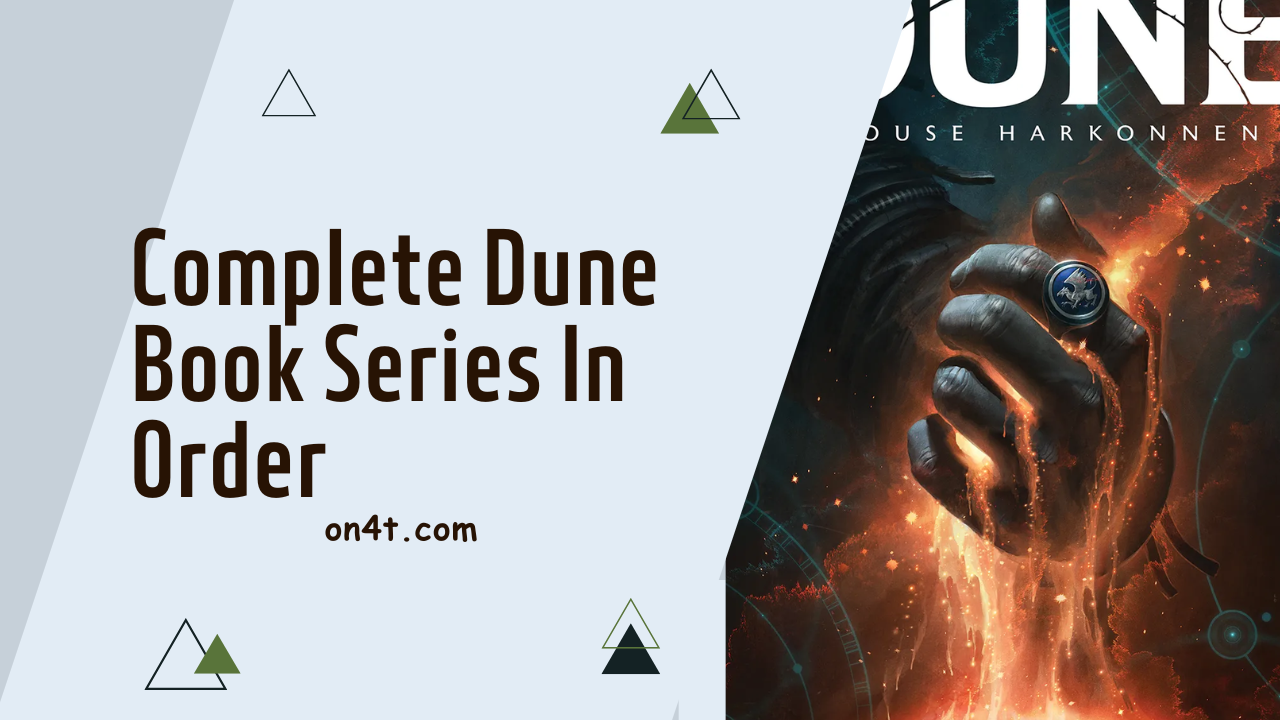The Dune book series, created by Frank Herbert, is a captivating science fiction saga renowned for its rich world-building and intricate plotlines. Set in a distant future where noble houses vie for control over the desert planet Arrakis, the series delves into themes of politics, religion, and ecology amidst epic battles and complex characters.
In this article, we will discuss the chronological order of the Dune book series, providing readers with a clear roadmap to explore the intricate narrative crafted by Herbert and continued by other authors in the Dune universe.
Understanding Dune Book Series
The “Dune” series, by Frank Herbert, is a towering landmark in science fiction, known for its epic scope, complex themes, and the depth of its philosophical and ecological insights. The series kicks off with the original “Dune” novel in 1965, which is often hailed as one of the greatest science fiction novels of all time. Here’s a brief overview to help you get started:
Core Themes
- Politics and Power: The series dives deep into the machinations of interstellar politics, power struggles among noble families, religious sects, and the Imperium.
- Ecology and Environment: Herbert was ahead of his time in emphasizing ecological themes, focusing on the planet Arrakis (also known as Dune), its desert environment, and the precious, spice-producing sandworms.
- Religion and Philosophy: The books explore various religious and philosophical ideas, including prophecy, messianism, and the hero’s journey, drawing from multiple real-world traditions.
- Human Potential: The training and mental disciplines of various groups in the series (like the Bene Gesserit and the Mentats) delve into the limits and potentials of the human mind.
Main Books
- Dune (1965): The saga begins with the story of Paul Atreides, whose family accepts stewardship of the desert planet Arrakis, the only source of the universe’s most valuable substance, the spice melange.
- Dune Messiah (1969): This sequel deals with the consequences of Paul’s rise to power and the complexities of his prophesied role.
- Children of Dune (1976): Focuses on Paul’s children, Leto II and Ghanima, and their roles in the evolving landscape of Arrakis and the wider universe.
- God Emperor of Dune (1981): Set thousands of years later, it follows Leto II, who has transformed into a sandworm-human hybrid, and his long-term vision for humanity.
- Heretics of Dune (1984): Takes place after another significant time jump, focusing on the Bene Gesserit, the Tleilaxu, and other factions vying for control in a changed universe.
- Chapterhouse: Dune (1985): Continues the story of the Bene Gesserit as they struggle against their enemies and deal with a new Dune.
Beyond Frank Herbert
After Frank Herbert’s death, his son Brian Herbert, along with author Kevin J. Anderson, expanded the universe with prequels, sequels, and interquels based on Frank Herbert’s notes and unpublished works. These books delve into the history of the Dune universe, offering backstories and expanding on the lore.
Impact and Influence
“Dune” has left an indelible mark on the science fiction genre, influencing countless works in literature, film, TV, and video games. Its themes of ecological conservation, the dangers of absolute power, and the blending of religious and philosophical thought remain relevant today. The series’ complex narrative and detailed universe have also set a high standard for world-building in science fiction.

Understanding “Dune” is like exploring a vast desert planet full of hidden treasures and lurking dangers. It’s a series that rewards patience and contemplation, offering new insights with each reading. Whether you’re drawn to its political intrigue, ecological themes, or philosophical questions, “Dune” has something to offer every reader.
Complete Dune Book Series In Order
- Dune (1965)
- Dune Messiah (1969)
- Children of Dune (1976)
- God Emperor of Dune (1981)
- Heretics of Dune (1984)
- Chapterhouse: Dune (1985)
- House Atreides (1999)
- House Harkonnen (2000)
- House Corrino (2001)
- The Butlerian Jihad (2002)
- The Machine Crusade (2003)
- The Battle of Corrin (2004)
- Hunters of Dune (2006)
- Sandworms of Dune (2007)
- Paul of Dune (2008)
- The Winds of Dune (2009)
- Sisterhood of Dune (2011)
- Mentats of Dune (2014)
- Navigators of Dune (2016)
- The Duke of Caladan (2020)
- The Lady of Caladan (2021)
- The Heir of Caladan (2022)
FAQs
What is the Dune book series about?
The Dune series is a science fiction saga set in a distant future where noble houses control planets, and a valuable substance called “spice” enables space travel. It follows the journey of young Paul Atreides as he navigates politics, religion, and warfare.
Who is the author of the Dune book series?
Frank Herbert, an American author, wrote the Dune series. He began with “Dune” in 1965, followed by several sequels. After his passing, his son, Brian Herbert, co-authored prequels and sequels based on his father’s notes.
What is the significance of the “spice” in the Dune universe?
Spice, also known as melange, is a highly coveted substance in the Dune universe. It grants extended life, heightened awareness, and facilitates space travel. Control over spice production is a central theme, driving political intrigue and conflict throughout the series.
How many books are in the Dune series?
The original Dune series consists of six books written by Frank Herbert. They are “Dune,” “Dune Messiah,” “Children of Dune,” “God Emperor of Dune,” “Heretics of Dune,” and “Chapterhouse: Dune.” Additionally, there are prequels and sequels authored by Frank Herbert’s son and co-author, Brian Herbert, extending the series.
Conclusion
Understanding the sequence of the Dune book series is crucial for an enjoyable reading experience. The correct order is: “Dune,” “Dune Messiah,” “Children of Dune,” “God Emperor of Dune,” “Heretics of Dune,” and “Chapterhouse: Dune.”
Moreover, On4t Online TTS tool offers a convenient solution for adding stylish subtitles to videos quickly. Its user-friendly interface and efficient processing make it a valuable asset for content creators seeking to enhance their video content with visually appealing subtitles.